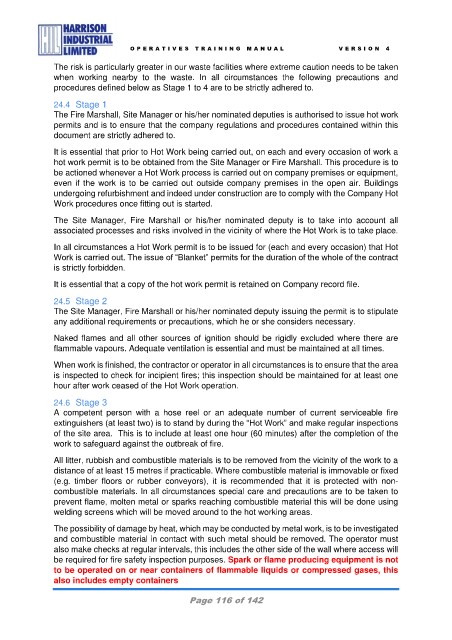Page 117 - HIL Operatives Training Manual V4 16022024_Neat
P. 117
O P E R A T I V E S T R A I N I N G M A N U A L V E R S I O N 4
The risk is particularly greater in our waste facilities where extreme caution needs to be taken
when working nearby to the waste. In all circumstances the following precautions and
procedures defined below as Stage 1 to 4 are to be strictly adhered to.
24.4 Stage 1
The Fire Marshall, Site Manager or his/her nominated deputies is authorised to issue hot work
permits and is to ensure that the company regulations and procedures contained within this
document are strictly adhered to.
It is essential that prior to Hot Work being carried out, on each and every occasion of work a
hot work permit is to be obtained from the Site Manager or Fire Marshall. This procedure is to
be actioned whenever a Hot Work process is carried out on company premises or equipment,
even if the work is to be carried out outside company premises in the open air. Buildings
undergoing refurbishment and indeed under construction are to comply with the Company Hot
Work procedures once fitting out is started.
The Site Manager, Fire Marshall or his/her nominated deputy is to take into account all
associated processes and risks involved in the vicinity of where the Hot Work is to take place.
In all circumstances a Hot Work permit is to be issued for (each and every occasion) that Hot
Work is carried out. The issue of “Blanket” permits for the duration of the whole of the contract
is strictly forbidden.
It is essential that a copy of the hot work permit is retained on Company record file.
24.5 Stage 2
The Site Manager, Fire Marshall or his/her nominated deputy issuing the permit is to stipulate
any additional requirements or precautions, which he or she considers necessary.
Naked flames and all other sources of ignition should be rigidly excluded where there are
flammable vapours. Adequate ventilation is essential and must be maintained at all times.
When work is finished, the contractor or operator in all circumstances is to ensure that the area
is inspected to check for incipient fires; this inspection should be maintained for at least one
hour after work ceased of the Hot Work operation.
24.6 Stage 3
A competent person with a hose reel or an adequate number of current serviceable fire
extinguishers (at least two) is to stand by during the “Hot Work” and make regular inspections
of the site area. This is to include at least one hour (60 minutes) after the completion of the
work to safeguard against the outbreak of fire.
All litter, rubbish and combustible materials is to be removed from the vicinity of the work to a
distance of at least 15 metres if practicable. Where combustible material is immovable or fixed
(e.g. timber floors or rubber conveyors), it is recommended that it is protected with non-
combustible materials. In all circumstances special care and precautions are to be taken to
prevent flame, molten metal or sparks reaching combustible material this will be done using
welding screens which will be moved around to the hot working areas.
The possibility of damage by heat, which may be conducted by metal work, is to be investigated
and combustible material in contact with such metal should be removed. The operator must
also make checks at regular intervals, this includes the other side of the wall where access will
be required for fire safety inspection purposes. Spark or flame producing equipment is not
to be operated on or near containers of flammable liquids or compressed gases, this
also includes empty containers
Page 116 of 142

